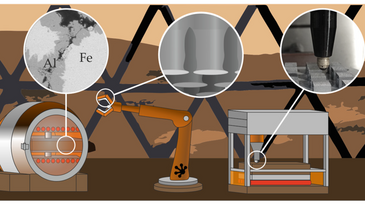Nicole Mensching, Mirja Louisa Krüger, Askar Kvaratskheliya, Daniel Meyer, Kirsten Tracht, Ilya Okulov and Lutz Mädler
Materials 16 (2023), 4170
doi: https://doi.org/10.3390/ma16114170, preprint available open access: doi:https://www.preprints.org/manuscript/202304.1169/v1
Once on Mars, maintenance and repair will be crucial for humans as supply chains including Earth andMars will be very complex. Consequently, the raw material available on mars must be processed and used. Factors such as the energy available for material production play just as important a role as the quality of the material that can be produced and the quality of its surface. With the aim of developing and technically implementing a process chain that meets the challenge of producing spare parts from oxygen-reduced Mars regolith, this paper addresses the issue of low-energy handling. Expected statistically distributed high roughnesses of sintered regolith analogs are approximated in this work by parameter variation in the PBF-LB/M process. For low-energy handling, a dry-adhesive microstructure is used. Investigations are carried out to determine the extent to which the rough surface resulting from the manufacturing process can be smoothed by deep rolling in such a way that the microstructure adheres and enables samples to be transported. For the investigated AlSi10Mg samples (12 mm x 12 mm x 10 mm), the surface roughness varies in a wide range from Sa 7.7 µm to Sa 64 µm after the additive manufacturing process, pull-off stresses of up to 6.99 N/cm² could be realized after deep rolling. This represents an increase in pull-off stresses by a factor of 392.94 compared to the pull-off stresses before deep rolling, enabling handling of even larger specimens. It is noteworthy that specimens with roughness values that were previously difficult to handle can be treated post-deep rolling, indicating a potential influence of additional variables that describe roughness or ripples and are associated with the adhesion effect of the microstructure of the dry adhesive.
© The Authors 2023 licensed under CC BY 4.0
This publication is a result of the Humans on Mars Initiative.


